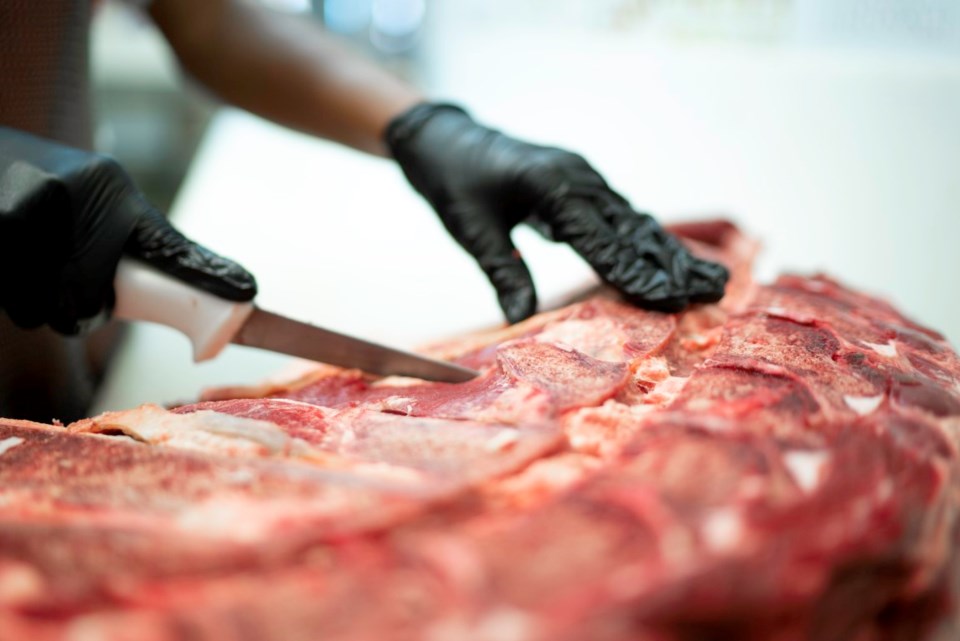ASSINIBOIA — Adding capacity to Saskatchewan’s beef processing sector can be done but with competitive challenges, according to study results.
Consultants Willie Van Solkema, former president of XL Foods, and Kevin Grier, long-time industry analyst, conducted the study for the Saskatchewan government and Saskatchewan Stock Growers Association.
The government has a goal to double capacity by 2030 and that raised questions about how and whether that could be done.
Van Solkema told the SSGA annual convention June 6 that the province has the cattle supply, with about 150,000 slaughter steers and heifers in Saskatchewan at any one time, and a relatively stable herd.
However, a new plant to slaughter and process between 400 and 500 head each day would cost about $120 million. A 1,000-head-per-day plant would cost more than $200 million.
“If you build a plant of about 1,000 head a day, you’d basically not just supplying all of Saskatchewan, but you’d have 60,000 tonnes of meat to move out of the province,” he said.
“You are going to come into direct competition with the two big plants in Alberta.”
Smaller plants would run about $50 to $100 per head behind the larger facilities in terms of efficiency, he said.
Those higher costs mean doing things to become more competitive and maximize revenue.
For example, he said rail boning cows would offer an advantage.
“All your plants right now even though they do steers and cows, they’re all done on the table,” he explained.
Most were built as fed cattle plants, not cow plants, he said. When he ran XL Foods the company had a specific line to rail bone cows, and the expense load of that plant compared favourably to the two big facilities, he said.
“We could take our cost of slaughter, cost of cow boning and we were less than the two big guys from a total cost standpoint. To me that’s a big opportunity,” he said. “More than likely you’re going to do some fed cattle and you’re going to do cows. One thing I would absolutely do is when you’re engineering the plant make sure you find the most efficient way to bone out those animals, especially those cows.”
A new plant should offer custom processing to generate revenue. It should also be engineered to handle bison, which bring in good money, Van Solkema said.
One advantage for a new plant would be to build to European Union standards so that producers could take advantage of trade agreements.
The larger processors are not EU compliant and never will be, he said.
Some export customers, Japan for example, prefer branded products and a Saskatchewan brand might be a selling feature.
“You don’t need 50 different customers in those markets. You need one or two that will pay the most money,” he said.
Slaughter operations have remained virtually unchanged for years, he said, but there have been improvements for more humane movement through the plant and multiple intervention techniques used in the larger ones. These include things such as acid washes, steam vacuums and pasteurization systems.
One big difference between large and small plants is the use of spray chilling. Smaller plants that don’t spray chill see shrink of between one and 1.25 percent. The average shrink in a large plant is only .25 percent.
That may not sound like much, but Van Solkema said on an 850-pound animal that one percent loss could equate to $20 per head.
“If you process a million cattle a year that’s a $20-million hit,” he said. “That’s why bigger plants use spray chill.”
Another technique the large plants use is 48-hour chill, which on fed cattle can improve grade by four to six percent for possibly another $15 to $20 per head.
Van Solkema said a new plant should have a strong sorting system that can segregate grades and get more value from each carcass.
Ground beef lines are becoming more common as retailers get out of doing that in-house.
And there are other things for potential builders to think about, from automated box storage to ensure proper rotation to what they will do with material to be rendered.
There is one rendering plant in Saskatoon but it only takes pork. Beef is considered a prohibitive product and the closest facility that takes it is in Calgary.
Specified risk material weighing about 120 pounds per cow and 30 pounds per fed animal also has to be dealt with and landfills are unlikely to take it.
“From a cost standpoint it just doesn’t make sense unless you’re going to build a plant with 4,000 plus head per day,” he said.
Water and wastewater, infrastructure, transportation, and labour are other concerns. One plant near Calgary has a system to recycle more than 90 percent of its water.
The larger plants have contracts with independent labs for E. coli testing and retailers are increasingly wanting third-party audits for their suppliers.
A temporary foreign worker program will be essential, he said, as young Canadians don’t want to work in meat plants.
Even at the management level, there is little practical experience and technical knowledge available in the province or even in Canada. Many existing senior managers are at retirement age, or they are in the United States.
A plant from start to finish would take between two and 2.5 years to complete.
Agriculture minister David Marit said he hasn’t yet considered the study’s findings.
“We heard a lot of challenges,” he said in an interview. “Are they challenges that can be overcome? Maybe they can be. Is there a place for government involvement? I think the business model has to show whether we’d be there or not.”
Marit said factors would be the cost and size of a proposed plant and where the economy of scale kicks in.





